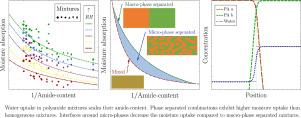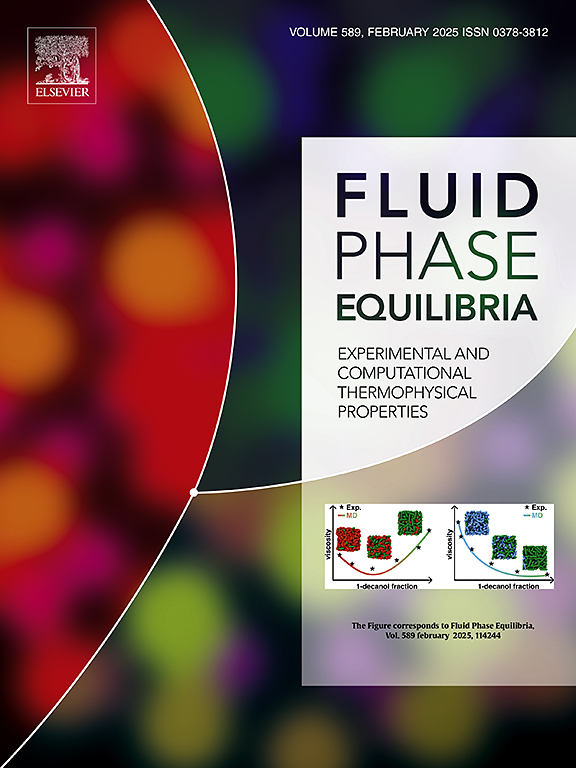Water absorption in aliphatic polyamide mixtures
IF 2.8
3区 工程技术
Q3 CHEMISTRY, PHYSICAL
引用次数: 0
Abstract
Essential properties of plastics, such as longevity and mechanical strength, depend on their water absorption capacity. In particular, the water uptake of polycondensates, like polyamides, strongly depends on their composition. To enhance physical characteristics, formulations of polyamide mixtures can be devised. Here, we present dynamic vapor sorption measurements, propose a theoretical approach to predict moisture uptake by aliphatic polyamide mixtures, and compare theoretical and experimental results. Experimental moisture uptake is determined for a wide range of relative humidities, using the weight difference of 10-15 mg samples measured with a specificity of . Our experimental results show that moisture uptake depends on composition and environmental humidity. Our theoretical model considers these dependencies in an extension of Flory–Huggins theory, and demonstrates semi-quantitative predictions of moisture absorption in various mixtures of PA 46, PA 48, PA 412, PA 418, and PA 436. The largest deviations are observed for the PA 46/PA 418 mixture, in which the measured moisture uptake is higher than the computed wt%. With a newly defined effective amide-concentration, the moisture uptake as a function of concentration can be predicted using a single master curve for different polyamide combinations. The absorption of water in a homogeneous polyamide mixture is found to be lower than in mixtures in which (micro-)phase separated domains are formed. The theory predicts up to 43% less moisture uptake in a homogeneous, 50/50 PA 46/PA 436 mixture compared to a phase separated mixture. Additionally, moisture uptake is marginally influenced by the volume of these domains and interfacial areas. The predictions regarding total miscibility and water absorption closely align with the experimental results obtained through dynamic vapor sorption measurements of moisture uptake. The proposed theoretical framework holds the potential to significantly contribute to the development of polyamides with optimized and more desirable properties.

脂肪族聚酰胺混合物的吸水性
塑料的基本特性(如使用寿命和机械强度)取决于其吸水性。特别是聚酰胺等聚缩聚物的吸水性在很大程度上取决于其成分。为了提高物理特性,可以设计聚酰胺混合物配方。在此,我们介绍了动态蒸汽吸附测量方法,提出了预测脂肪族聚酰胺混合物吸湿性的理论方法,并对理论和实验结果进行了比较。实验吸湿率是在很宽的相对湿度范围内,利用 10-15 毫克样品的重量差来测定的,其特异性为 0.1 微克。实验结果表明,吸湿性取决于成分和环境湿度。我们的理论模型在扩展 Flory-Huggins 理论时考虑了这些依赖性,并对 PA 46、PA 48、PA 412、PA 418 和 PA 436 的各种混合物的吸湿性进行了半定量预测。PA 46/PA 418 混合物的偏差最大,其中测量的吸湿率高于计算的 wt%。有了新定义的有效酰胺浓度,就可以用一条主曲线来预测不同聚酰胺组合的吸湿率与浓度的关系。研究发现,均质聚酰胺混合物的吸水率低于形成(微)相分离畴的混合物。根据理论预测,与相分离混合物相比,均质、50/50 PA 46/PA 436 混合物的吸湿率最高可降低 43%。此外,吸湿性受这些畴的体积和界面面积的影响很小。关于总混溶性和吸水性的预测与通过动态吸湿蒸汽测量获得的实验结果非常吻合。所提出的理论框架有望为开发具有优化和更理想特性的聚酰胺做出重大贡献。
本文章由计算机程序翻译,如有差异,请以英文原文为准。
求助全文
约1分钟内获得全文
求助全文
来源期刊

Fluid Phase Equilibria
工程技术-工程:化工
CiteScore
5.30
自引率
15.40%
发文量
223
审稿时长
53 days
期刊介绍:
Fluid Phase Equilibria publishes high-quality papers dealing with experimental, theoretical, and applied research related to equilibrium and transport properties of fluids, solids, and interfaces. Subjects of interest include physical/phase and chemical equilibria; equilibrium and nonequilibrium thermophysical properties; fundamental thermodynamic relations; and stability. The systems central to the journal include pure substances and mixtures of organic and inorganic materials, including polymers, biochemicals, and surfactants with sufficient characterization of composition and purity for the results to be reproduced. Alloys are of interest only when thermodynamic studies are included, purely material studies will not be considered. In all cases, authors are expected to provide physical or chemical interpretations of the results.
Experimental research can include measurements under all conditions of temperature, pressure, and composition, including critical and supercritical. Measurements are to be associated with systems and conditions of fundamental or applied interest, and may not be only a collection of routine data, such as physical property or solubility measurements at limited pressures and temperatures close to ambient, or surfactant studies focussed strictly on micellisation or micelle structure. Papers reporting common data must be accompanied by new physical insights and/or contemporary or new theory or techniques.
 求助内容:
求助内容: 应助结果提醒方式:
应助结果提醒方式:


